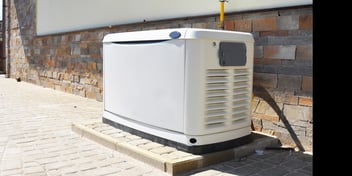Trend towards working from home
The COVID-19 pandemic and associated response and forced companies and employees to rethink work. While unemployment has skyrocketed in recent months, up to 20% of American employees are now working from home[1]. These workers, primarily white-collar knowledge professionals, are relying on their house or apartment’s capabilities to enable a comfortable and capable workplace. This shift from traditional offices with professional facility management to personal residences make workers more vulnerable to power outages and disruptions.
In 2017, the US Census estimated that 8 million Americans (or 5.2% of US workers) were actively working from home. These statistics represent a steady rise from 5% in 2016 and 3.3% in 2000[2]. Experts attribute this increase to shift to ubiquity of mobile computing devices, laxation of company policies, and influence of Silicon Valley culture.
Working from home has many benefits, including reducing time wasted during commutes, ability to connect with family during the workday, and potentially higher productivity[3]. To realize these benefits, employees need tools and capabilities that replace office functions. Tools might include collaboration software like Zoom or Google Hangouts and access to network resources through a VPN. Capabilities could include a comfortable spot to work, steady WiFi to access the internet, and ability to care for children while at home. While the company generally provides tools, capabilities are the responsibility of the employees. A key vulnerability of these capabilities is that they rely on grid power to work and an outage could be highly disruptive.
Frail electrical grid presents key vulnerability to working from home
The relative importance of reliable utility electricity makes the poor state of America’s power grid a scary proposition. The American Society of Civil Engineers gave the US electrical system a D+ grade due to outdated equipment, cybersecurity vulnerabilities, and line congestion. These deficiencies result in an expected rise in the number and duration of power outages. For example, in 2015, America experienced 3,571 unexpected outages with an average downtime of 49 minutes[4]. While the North American Electric Reliability Corporation (NERC) assesses that responses to outages are improving, they also recognize that extreme weather events continue to plague American electrical systems.
With much of America working from home and no quick fixes to improve the reliability of our electrical transmission systems, prepared workers should understand and prepare for potential blackouts. During a power outage, many key work from home systems will stop working while others will be degraded.
Full functionality in an outage:
- Utility water for facets and restrooms – water utilities backup pump systems with generators, meaning that water pressure should still be available during an outage
- Traditional phone service – Landline phones operate on a separate network
Partial functionality in an outage:
- Cell phones – will continue to connect to network provider towers (backed up by generators) but the phone will not be able to recharge
- Laptop computer – will continue to operate but will be limited by inability to recharge or connect to the internet
- Garage door – electric opening motor will stop functioning but manual override will still be available
- Utility natural gas – while the supply of natural gas will continue, the home’s furnace, hot water heater, digital thermostat, and blower require electricity to function
No functionality in an outage:
- WiFi router / internet modem – while the internet service provider likely has backup power, the modem and WiFI router inside the home will not function without power
- Air conditioning – once the power goes out, the A/C unit’s compressor and fans will not run
- Home lighting – traditional incandescent or LED bulbs will not function without power
- Other home appliances – refrigerators, freezers, coffee pots, and electric stoves will also not work during an outage
Backup power differs greatly from offices to homes
Prudent organizations take great care in ensuring that operations can continue during power outages. 80% of critical commercial and public facilities that rely on grid power have backup power systems to protect them during outages[5]. Compare that statistic with the estimated 3% of American homes that have backup generators and the capability gap becomes obvious[6]. The lack of backup power systems, such as an Uninterruptable Power Supply (UPS) combined with a natural gas generator or diesel generator, mean that the average home will be completely offline during an outage.
Over 2,000,000 homes have residential solar systems, which augment and replace grid power during normal operation. Some homeowners would be surprised to find out that most home solar systems are designed to work only when grid power is available. PV (photovoltaic) systems utilize transfer switches (also known as a switchboard) to manage electricity generated by the panels and grid power. These switches will automatically cut power if they detect a loss of grid power. While this might seem like a wasted capability, the purpose is to prevent back feeding power onto the grid while utility workers are repairing an outage.
Homeowners and renters can prepare for outages by purchasing and installing a generator. Home standby natural gas generators feature automatic transfer switches (ATS) that sense a grid outage and instantly start the generator. The combination of this equipment reduces the actions required of the homeowner coordinating regular maintenance. Natural gas and diesel standby generators can be sized for any home’s power requirements.
While standby generators require the coordination of electricians and occasionally plumbers, portable generators offer a flexible solution with minimal installation and setup. Gasoline generators start at 2 kW (kilowatts) and range up to 12 kW (12,000 watts). Diesel generators start larger (6 kW) and increase in size up to trailer-mounted generators. A distinct advantage of mobile generators is that they can be used in a variety of situations – power outage, sports tailgate, camping, or at a remote construction site.
[1] https://www.statista.com/statistics/1110076/share-adults-work-situation-covid-19-us/
[2] https://qz.com/work/1392302/more-than-5-of-americans-now-work-from-home-new-statistics-show/#:~:text=The%20steady%20rise%20of%20Americans,%2C%20and%203.3%25%20in%202000.
[3] https://hbr.org/2014/01/to-raise-productivity-let-more-employees-work-from-home
[4] https://www.infrastructurereportcard.org/energy/conditions-capacity/
[5] https://publications.anl.gov/anlpubs/2016/05/127089.pdf
[6] https://propane.com/2018/09/24/standby-generators-can-be-a-differentiator-in-new-construction/#:~:text=%E2%80%9CThough%20Generac%20holds%20a%2070,%2C%E2%80%9D%20reporter%20Laura%20McNulty%20writes.
RELATED POSTS
Proin auctor nibh vitae urna lobortis, in vulputate erat facilisis. Sed lacinia lorem eget orci finibus, et maximus nisi sagittis.

Standby And Portable Generators For Emergency Power
Wherever you may live in the world, a power outage is always a possibility and a concern. During an extended power outage, your home or business...
Read more »
Consumer Generator Basics – Home Standby & Portable Generators
The two questions of “what kind of generator do I need” and “how big of a generator do I need” are the most common areas of concern for people...
Read more »
How to Choose the Right Generator
In an ideal world, there wouldn’t be natural disasters that cause wide-spread power outages, property damage, and loss of life. But the unfortunate...
Read more »
